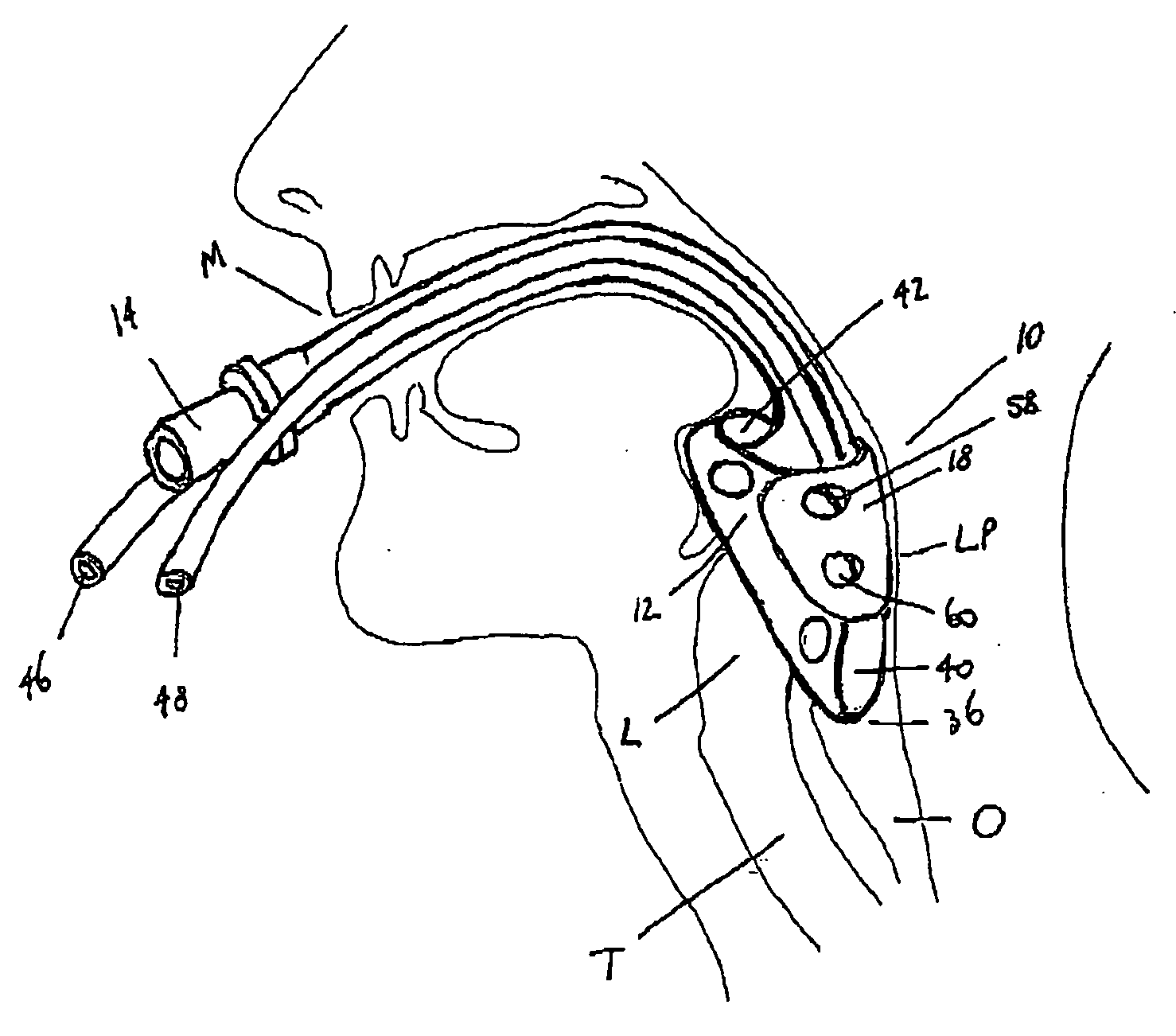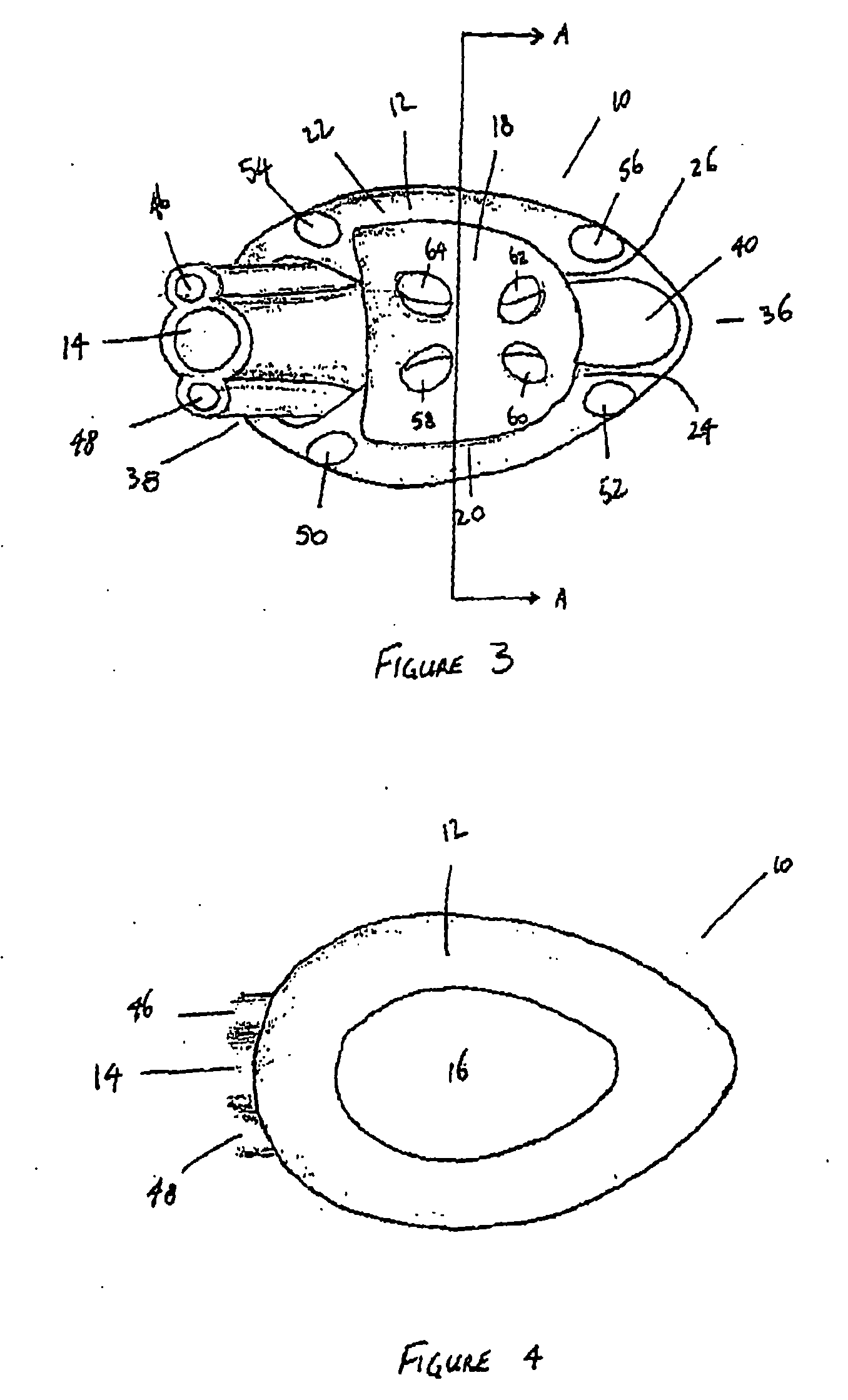[0015] In its most general form, the present invention relates to a device for maintaining an airway in a patient comprising a mask, the mask having a resilient conformable
peripheral portion shaped such that the mask forms a seal with the larynx when the mask is positioned in the laryngo pharynx to thereby prevent ingress of extraneous fluids into the larynx, the peripheral portion of the mask defining at least one cavity for providing fluid communication to the
esophagus when the mask is inserted into the laryngo pharynx, and an airway tube connected to or formed with the mask for passing gas to the larynx when the mask is properly inserted into the laryngo pharynx.
[0016] In a first aspect, the present invention provides a device for maintaining an airway in a patient comprising a mask, the mask having a resilient conformable peripheral portion shaped such that the mask forms a seal with the larynx when the mask is positioned in the laryngo pharynx to thereby prevent ingress of extraneous fluids into the larynx, the peripheral portion of the mask defining at least one cavity for providing fluid communication between the laryngo pharynx and the esophagus when the mask is inserted into the laryngo pharynx, and an airway tube connected to or formed with the mask for passing gas to the larynx when the mask is properly inserted into the laryngo pharynx.
[0020] The mask, when properly inserted, has a laryngeal side and a laryngo pharynx side. Preferably, the laryngo pharynx side is provided with a contact member for contacting a wall of the laryngo pharynx, the contact member assisting in spacing of the peripheral portion of the mask from the laryngo pharynx wall to thereby facilitate formation of a seal with the larynx.
[0028] Suitably, the inner wall of the mask is arranged to facilitate maintenance of the depth of the airway depression and to maintain pressure against the surrounding areas of the larynx to maintain the seal against ingress of
gastric juices into the larynx and to allow
positive pressure ventilation of the airway. A combination of the resilience of the inner wall and the dimensions of the inner wall are used to obtain these effects.
[0036] The mask may have an airway tube that is shaped such that it includes a section that curves towards the laryngeal side of the mask. Preferably, the device of the second aspect of the invention has an airway tube that curves downwardly towards the laryngeal side of the mask at a region located adjacent a proximal end of the mask. In this embodiment,
insertion of the mask is much easier as the curvature of the tubing tends to move the mask into the airway and towards the larynx without necessarily requiring external guidance by the anesthetist placing his or her fingers in close proximity to or in contact with the mask, which is commonly required with conventional
laryngeal masks.
[0037] In a second aspect, the present invention provides a device for maintaining an airway in a patient comprising a mask, the mask having a resilient conformable peripheral portion shaped such that the mask forms a seal with the larynx when the mask is positioned in the laryngo pharynx to thereby prevent ingress of extraneous fluids into the larynx, a first tube having a outlet at a distal end thereof, the outlet of the first tube being in fluid communication with the esophagus when the mask is in use, a second tube having an opening at a distal end thereof, the opening of the second fluid tube being separate to the opening of the first tube, the opening of the second fluid tube being in fluid communication with the esophagus when the mask is in use, the first fluid tube adapted to remove fluids from the laryngo pharynx side of the mask in use, the second fluid tube adapted to provide venting fluid to the laryngo pharynx side of the mask in use and an airway tube connected to or formed with the mask for passing gas to the larynx when the mask is properly inserted into the laryngo pharynx.
 Login to View More
Login to View More  Login to View More
Login to View More 









